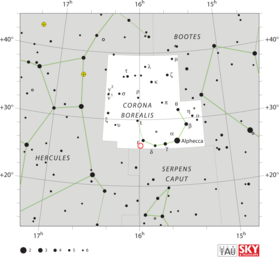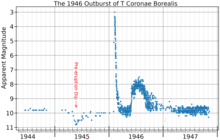astro.wikisort.org - Star
T Coronae Borealis (T CrB), is a recurring nova in the constellation Corona Borealis. It was first discovered in outburst in 1866 by John Birmingham,[11] although it had been observed earlier as a 10th magnitude star.[12]
 | |
| Observation data Epoch J2000 Equinox J2000 | |
|---|---|
| Constellation | Corona Borealis |
| Right ascension | 15h 59m 30.1622s[1] |
| Declination | 25° 55′ 12.613″[1] |
| Apparent magnitude (V) | 2.0–10.8[2] |
| Characteristics | |
| Evolutionary stage | Red giant + white dwarf |
| Spectral type | M3III+p |
| Variable type | recurrent nova[2] |
| Astrometry | |
| Radial velocity (Rv) | −27.79[4] km/s |
| Proper motion (μ) | RA: −4.220[5] mas/yr Dec.: 12.364[5] mas/yr |
| Parallax (π) | 1.2127 ± 0.0488 mas[5] |
| Distance | 806+34 −30[6] pc |
| Orbit | |
| Period (P) | 227.8 d[7] |
| Semi-major axis (a) | 0.54 AU[6] |
| Eccentricity (e) | 0.0[7] |
| Inclination (i) | 67[8]° |
| Details | |
| Red giant | |
| Mass | 1.12[6] M☉ |
| Radius | 75[8] R☉ |
| Luminosity | 655[9] L☉ |
| Surface gravity (log g) | 2.0[10] cgs |
| Temperature | 3,600[10] K |
| White dwarf | |
| Mass | 1.37[6] M☉ |
| Luminosity | ~100[8] L☉ |
| Other designations | |
| Database references | |
| SIMBAD | data |
Description

T CrB normally has a magnitude of about 10, which is near the limit of typical binoculars. It has been seen to outburst twice, reaching magnitude 2.0 on May 12, 1866 and magnitude 3.0 on February 9, 1946,[13] although a more recent paper shows the 1866 outburst with a possible peak range of magnitude 2.5 ± 0.5.[14] Even when at peak magnitude of 2.5, this recurrent nova is dimmer than about 120 stars in the night sky.[15] It is sometimes nicknamed the Blaze Star.[16]
T CrB is a binary system containing a large cool component and a smaller hot component. The cool component is a red giant which is transferring material to the hot component. The hot component is a white dwarf surrounded by an accretion disc, all hidden inside a dense cloud of material from the red giant. When the system is quiescent, the red giant dominates the visible light output and the system appears as an M3 giant. The hot component contributes some emission and dominates the ultraviolet output. During outbursts, the transfer of material to the hot component increases greatly, the hot component expands, and the luminosity of the system increases.[6][8][17] [18]

The two components of the system orbit each other every 228 days. The orbit is almost circular and is inclined at an angle of 67°. The stars are separated by 0.54 AU.[6]
2016-present activity
On 20 April 2016, the Sky and Telescope website reported a sustained brightening since February 2015 from magnitude 10.5 to about 9.2. A similar event was reported in 1938, shortly before the 1946 outburst.[19] As of June 2018, the star has dimmed slightly but still remains at an unusually high level of activity.
References
- Gaia Collaboration; et al. (November 2016). "Gaia Data Release 1. Summary of the astrometric, photometric, and survey properties". Astronomy & Astrophysics. 595: 23. arXiv:1609.04172. Bibcode:2016A&A...595A...2G. doi:10.1051/0004-6361/201629512. S2CID 1828208. A2.
- Samus, N. N.; Durlevich, O. V.; et al. (2009). "VizieR Online Data Catalog: General Catalogue of Variable Stars (Samus+ 2007-2013)". VizieR On-line Data Catalog: B/GCVS. Originally Published in: 2009yCat....102025S. 1. Bibcode:2009yCat....102025S.
- Pourbaix, D.; Tokovinin, A. A.; Batten, A. H.; Fekel, F. C.; Hartkopf, W. I.; Levato, H.; Morrell, N. I.; Torres, G.; Udry, S. (2004). "SB9: The ninth catalogue of spectroscopic binary orbits". Astronomy and Astrophysics. 424 (2): 727–732. arXiv:astro-ph/0406573. Bibcode:2004A&A...424..727P. doi:10.1051/0004-6361:20041213. S2CID 119387088.
- Brown, A. G. A.; et al. (Gaia collaboration) (August 2018). "Gaia Data Release 2: Summary of the contents and survey properties". Astronomy & Astrophysics. 616. A1. arXiv:1804.09365. Bibcode:2018A&A...616A...1G. doi:10.1051/0004-6361/201833051. Gaia DR2 record for this source at VizieR.
- Linford, Justin D.; Chomiuk, Laura; Sokoloski, Jennifer L.; Weston, Jennifer H. S.; Van Der Horst, Alexander J.; Mukai, Koji; Barrett, Paul; Mioduszewski, Amy J.; Rupen, Michael (2019). "T CRB: Radio Observations during the 2016-2017 "Super-active" State". The Astrophysical Journal. 884 (1): 8. arXiv:1909.13858. Bibcode:2019ApJ...884....8L. doi:10.3847/1538-4357/ab3c62. S2CID 203593955.
- Fekel, Francis C.; Joyce, Richard R.; Hinkle, Kenneth H.; Skrutskie, Michael F. (2000). "Infrared Spectroscopy of Symbiotic Stars. I. Orbits for Well-Known S-Type Systems". The Astronomical Journal. 119 (3): 1375. Bibcode:2000AJ....119.1375F. doi:10.1086/301260.
- Stanishev, V.; Zamanov, R.; Tomov, N.; Marziani, P. (2004). "Hα variability of the recurrent nova T Coronae Borealis". Astronomy and Astrophysics. 415 (2): 609–616. arXiv:astro-ph/0311309. Bibcode:2004A&A...415..609S. doi:10.1051/0004-6361:20034623. S2CID 3000175.
- Schaefer, Bradley E. (2009). "Orbital Periods for Three Recurrent Novae". The Astrophysical Journal. 697 (1): 721–729. arXiv:0903.1349. Bibcode:2009ApJ...697..721S. doi:10.1088/0004-637X/697/1/721. S2CID 16087253.
- Wallerstein, George; Harrison, Tanya; Munari, Ulisse; Vanture, Andrew (2008). "The Metallicity and Lithium Abundances of the Recurring Novae T CrB and RS Oph". Publications of the Astronomical Society of the Pacific. 120 (867): 492. Bibcode:2008PASP..120..492W. doi:10.1086/587965.
- Pettit, Edison (1946). "The Light-Curves of T Coronae Borealis". Publications of the Astronomical Society of the Pacific. 58 (341): 153. Bibcode:1946PASP...58..153P. doi:10.1086/125797.
- Barnard, E. E. (1907). "Nova T Coronae of 1866". Astrophysical Journal. 25: 279. Bibcode:1907ApJ....25..279B. doi:10.1086/141446.
- Sanford, Roscoe F. (1949). "High-Dispersion Spectrograms of T Coronae Borealis". Astrophysical Journal. 109: 81. Bibcode:1949ApJ...109...81S. doi:10.1086/145106.
- Schaefer, Bradley E. (2010). "Comprehensive Photometric Histories of All Known Galactic Recurrent Novae". The Astrophysical Journal Supplement Series. 187 (2): 275–373. arXiv:0912.4426. Bibcode:2010ApJS..187..275S. doi:10.1088/0067-0049/187/2/275. S2CID 119294221.
- "Vmag<2.5". SIMBAD Astronomical Database. Retrieved 2010-06-25.
- A Digital Spectral Classification Atlas, R. O. Gray, 34. Unusual Stellar Spectra III: two emission-line stars
- Iłkiewicz, Krystian; Mikołajewska, Joanna; Stoyanov, Kiril; Manousakis, Antonios; Miszalski, Brent (2016). "Active phases and flickering of a symbiotic recurrent nova T CrB". Monthly Notices of the Royal Astronomical Society. 462 (3): 2695. arXiv:1607.06804. Bibcode:2016MNRAS.462.2695I. doi:10.1093/mnras/stw1837. S2CID 119104759.
- Luna, GJM; Mukai, K.; Sokoloski, J. L.; Nelson, T.; Kuin, P.; Segreto, A.; Cusumano, G.; Jaque Arancibia, M.; Nuñez, N. E. (2018). "Dramatic change in the boundary layer in the symbiotic recurrent nova T Coronae Borealis". Astronomy and Astrophysics. 619 (1): 61. arXiv:1807.01304. Bibcode:2018A&A...619A..61L. doi:10.1051/0004-6361/201833747. S2CID 119078482.
- "Is T CrB About to Blow its Top?". Sky & Telescope website. 20 April 2016. Retrieved 2017-08-06.
Further reading
- Wallerstein, George; Tanya Harrison; Ulisse Munari; Andrew Vanture (11 May 2008). "The Metallicity and Lithium Abundances of the Recurring Novae T CrB and RS Oph". Publications of the Astronomical Society of the Pacific. 120 (867): 492–497. Bibcode:2008PASP..120..492W. doi:10.1086/587965.
- R and T Coronae Borealis: Two Stellar Opposites at Sky & Telescope
External links
- http://www.daviddarling.info/encyclopedia/B/Blaze_Star.html
- AAVSO: Quick Look View of AAVSO Observations (get recent magnitude estimates for T CrB)
На других языках
[de] T Coronae Borealis
T Coronae Borealis (kurz T CrB) ist eine circa 2.000 Lichtjahre entfernte rekurrierende (wiederkehrende) Nova im Sternbild Nördliche Krone. T Coronae Borealis ist normalerweise 10,8 mag hell, erreichte aber bei den beiden letzten Ausbrüchen 1866 und 1946 2,0 mag.- [en] T Coronae Borealis
[es] T Coronae Borealis
T Coronae Borealis (T CrB / HD 143454 / HR 5958) es una nova recurrente en la constelación de Corona Borealis, descubierta el 12 de mayo de 1866 por el astrónomo irlandés John Birmingham. Habitualmente de magnitud aparente +10,8, en los últimos estallidos de 1866 y 1946 alcanzó magnitud +2,0.[ru] T Северной Короны
T Северной Короны, (T Coronae Borealis, T CrB) — звезда в созвездии Северной Короны. Она имеет неофициально название англ. Blaze Star (Полыхающая звезда) [5] и является одной из немногих известных повторных новых. Как правило, её светимость имеет величину около 10m, что находится вблизи границы разрешения типичных биноклей. Однако за время наблюдения было зарегистрировано две вспышки: первый раз 12 мая 1866 года, когда она достигла светимости 2,0m и во второй раз 9 февраля 1946 года когда её яркость достигла величины 3,0m[6]. Правда более новая статья (от 2009 года) показывает, что вспышка 1866 года имела возможное пиковое значение светимости в диапазоне 2,5 ± 0,5.[7]. Но даже когда на пике своей светимости она достигала величины 2,5m, то эта повторная новая уступала по яркости только лишь 163 звездам в ночном небе[8], а если её светимость достигала величины 2,0m, то тогда она была 109-ой звёздой по яркости[9]. Сама T CrB является спектрально-двойной звездой состоящей из красного гиганта и белого карлика, который обращается вокруг главной звезды с периодом 227,6 дней[4].Другой контент может иметь иную лицензию. Перед использованием материалов сайта WikiSort.org внимательно изучите правила лицензирования конкретных элементов наполнения сайта.
WikiSort.org - проект по пересортировке и дополнению контента Википедии